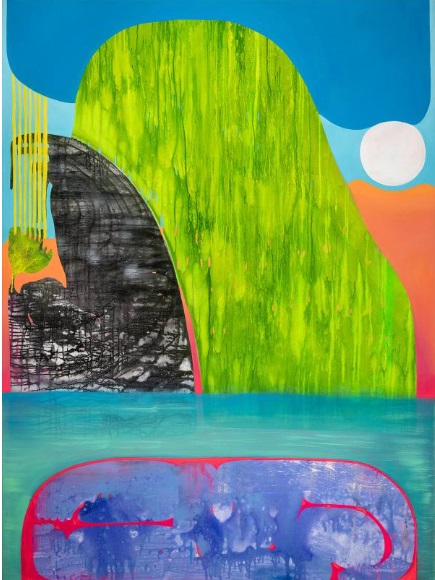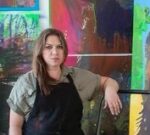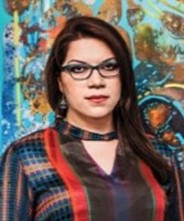Ricki Morse – Vian Sora: Her Presence Through Mythology, History, Conflict and Beauty

Vian Sora
Iraqi, 1976- (active USA)
Dilmun, 2022
oil and mixed media on canvas
80 × 60 in.
SBMA, Museum purchase with funds provided by the General Art Acquisition Fund
2023.42

Vian Sora in her Louisville, Kentucky studio in 2023 (photo by Mindy Best)
“By relinquishing control of the paint itself and allowing it to work on the canvas, my work attains a measure of hope: if nothing is settled and determined, any outcome is still possible, thus I utilize vibrant contrasting colors set often on burnt or earth tones.”
- Vian Sora
RESEARCH PAPER
”Dilmun” is about a place. It was a lost ancient city in Mesopotamia (now Bahrain) that was considered a pure and holy land. “Dilmun” is a painting begun in 2021 during Sora’s residency in Berlin, a city reminiscent of Baghdad, once devastated by war. The split between destruction and renewal remains real and visible.
Sora’s paintings are infused with emotional tension and based on confronting destruction and decay. She uses bold color contrast within abstract landscapes. Sora’s vision fuses her own experience with Iraqi history, cultural identity influences, and painterly abstraction. Though they are largely abstract, Sora’s paintings suggest figures and places, including landscapes of lush fertility and cycles of life and death. Her only formal training in art was studying printmaking in Istanbul, Turkey for a year starting in 2006.
Vian Sora believes that society moves within a cycle of chaos and regeneration. To realize this in a visual way she first covers the surface of her painting with the overall “chaos” of poured paint, drips, splatters and moving color fields. The regeneration occurs when she then goes back in with bright opaque paint to create a metaphorical landscape of shapes that provide order and direction to the composition.
From the window of her studio, Sora could see a WWII park and amidst the park’s mounds sits a memorial for Trümmerfrauen, the “rubble women” who helped rebuild the city after 1945. In a nod to the tireless efforts of these women, this work includes curious knolls. Plant life, suggestions of architecture and hidden figures present a tension between figuration and abstraction.
Among the mounds and suggestions of landscape there is a moon and a leaf to help apply order and rebirth to the chaos of the background washes and drips. Her use of color and shape pulls your eye up from the figure at the bottom through the water and landscape to the moon and sky at the top.
Upon closer examination the figure floating in the water may be one of the thousands of people buried in the mounds that are all over the island. The green hill above symbolizes this mound and the black hill is the decaying architecture that is also on the island. To the far left is a palm leaf receiving rain or Sundays in a cycle of rebirth. In this way Sora works through all of her emotions about the place where she lived and the lives and cycles of nature that exist there.
It now becomes clear that her residency in Berlin helped her to make the connection between the “rubble women” from the park and the burial mounds in her ancestral land.
Vian Sora avoids depriving herself of corporality and materiality: “Bodies are always there, deep under the colors.” She responds to the viewer’s urge to find a figure somewhere in the painting. “I am interested in creating a tension, a tight rope that you cannot break if you make a true balance.”
Speaking about her upcoming exhibition at the SBMA in June of 2025, Sora says: “I hope this exhibition will illuminate the struggle, courage and dissonance continuously faced by war survivors that exist between worlds. As displaced people and immigrants constantly strive to make sense of our new orbits, these paintings depict a journey through distant time and space in order to reach safety.”
Vian Sora’s paintings are informed by her life. Raised in Baghdad, she experienced many wars in Iraq:
Second Iraqi–Kurdish War (1974–1975)
Arvand Conflict (1974–1975)
Iran–Iraq War (1980–1988)
Invasion of Kuwait (1990)
Gulf War (1990– 1991)
Iraqi Kurdish Civil War (1995–1996)
Bombing of Iraq (1998)
Iraq War (2003–2011)
Prepared for the Santa Barbara Museum of Art Docent Council by Greg Farrington, 2025.
BIBLIOGRAPHY
AD (Architecture & Design) Middle East; (July 16, 2024, a Condé Nast publication.) “Vian Sora, the Iraqi-American Painter, Explores the Realities of Displacement and Being a Refugee” www.admiddleeast.com
Asia Society of Texas; (January 29, 2025) “Vian Sora: Outerworlds” www.asiasociety.org
Luis de Jesus Gallery, Los Angeles; (January 29, 2025) “email response from Jordan at Luis de Jesus Gallery to an inquiry by Greg Farrington to receive more specific information about the painting “Dilmun” that is owned by the SBMA”
Vian Sora website (January 29, 2025) www.viansora.com

Vian Sora courtesy of Louisville Visual Art
COMMENTS
The Santa Barbara Museum of Art is pleased to announce the acquisition of Vian Sora’s painting “Dilmun” (2022).
Vian Sora was born in Baghdad, obtained a degree in computer science, and left Iraq after living through the first Gulf War, years of sanctions, and the American invasion in 2003. After spending time in the United Arab Emirates and Turkey, she settled in Louisville, Kentucky. In recent years, she has painted abstractions that are at once joyous with vibrant colors and luscious passings of poured paint, but also fraught and conflicted. There are nearly always areas that look like a person, wings, a tree, and leaves, or something recognizable that wants to emerge from the elegant chaos of her drips and flows of paint, yet we cannot be sure exactly what these areas might be. In “Dilmun,” a body seems to float in water in the foreground, while a green expanse reminiscent of a desert oasis rises up in the center.
Dilmun is the ancient Sumerian name for a kingdom that existed along the shores of the Persian Gulf from about 4000 BCE to 800 BCE. It was a trade hub between cities in ancient Mesopotamia and the Indus Valley civilization in present day Pakistan.
Vian Sora is represented by Luis De Jesus Los Angeles, and is currently presenting her first New York solo exhibition “Vian Sora: End of Hostilities,” at David Nolan Gallery.
https://www.instagram.com/sbmuseart/p/CzmKFmxJ0j4/
